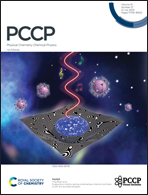Probing the dynamical interaction of the para-sulfonato-calix[4]arene with an antifungal protein†
Abstract
Calixarenes are hallmark molecules in supramolecular chemistry as hosts for small ligands. They have also conversely proved their interest as ligands toward assisted co-crystallization of proteins. These functionalized macrocycles target positively-charged residues, and notably surface-exposed lysines, with a site-selectivity finely characterized experimentally, but that remains to be assessed. Relying on a tailored molecular dynamics simulations protocol, we explore the association of para-sulfonato-calix[4]arenes with an antifungal protein, as a small yet most competitive system with 13 surface-exposed lysines. Our computational approach probes de novo the electrostatically-driven interaction, ruled out by a competition with salt bridges, corroborating the presence of two main binding sites probed by X-ray. The attach-pull-release (APR) method provides a very good assessment of the overall binding free energy measured experimentally (−6.42 ± 0.5 vs. −5.45 kcal mol−1 by isothermal titration calorimetry). This work also probes dynamic modifications upon ligand binding, and our computational protocol could be generalized to situate the supramolecular forces ruling out the calixarene-assisted co-crystallization of proteins.
![Graphical abstract: Probing the dynamical interaction of the para-sulfonato-calix[4]arene with an antifungal protein](/en/Image/Get?imageInfo.ImageType=GA&imageInfo.ImageIdentifier.ManuscriptID=D3CP01202F&imageInfo.ImageIdentifier.Year=2023)


 Please wait while we load your content...
Please wait while we load your content...